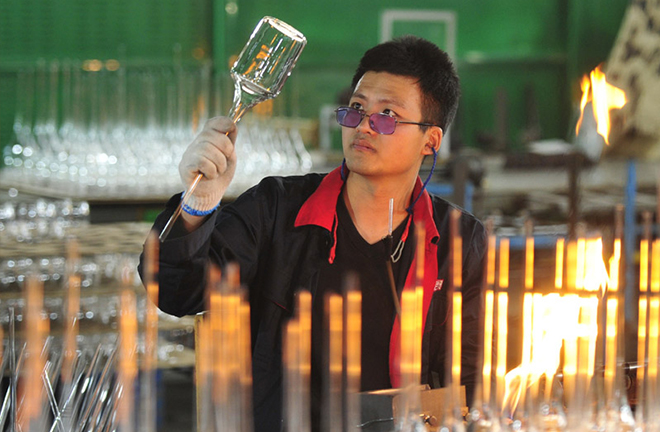New development pattern looks inward without turning inward

A worker examines an artistic glass product at a factory in Hebei Province. Photo: XINHUA
Since the outbreak of COVID-19, many export companies in China have started to look inward to the domestic market. Piles of high-quality export products have been sold domestically, enriching the domestic market supply and promoting consumption upgrades. This sector reveals on a smaller scale how China’s immense domestic demand supports the national economy at large.
“Since 2018, China’s absolute domestic market has been outsizing that of the United States. However, comparatively speaking China’s domestic flow of various factors and commodities faces greater obstacles. These obstacles will undoubtedly erode the advantages of the unitary market within the country. China has a population of more than 1.4 billion and its middle class exceeds 400 million. Its domestic market is vast. To promote the domestic economy circulation, it behooves us to remove the barriers facing the circulation of obvious and hidden factors in the domestic market and to shape the domestic unitary market by promoting the free flow of factors within China,” said Zhang Ming, director of the International Investment Research Office under the Institute of World Economics and Politics at the Chinese Academy of Social Sciences.
On April 9, 2020, the CPC Central Committee and the State Council issued a document requesting improvement of the factor market system and the removal of institutional hurdles which hinder the free flow of factors. The policy aims to create an environment where the market decides the factor price. Also, factors flow in a free and orderly way. The allocation of factors is efficient and fair. Zhang held that the policy will play a major role in smoothing the flow of domestic factors and shaping a unitary domestic market, if can be implemented effectively.
Zhang said that to boost the circulation of the domestic economy, China must guarantee that the consumer market continues to expand and consumption continues to upgrade. Therefore, it needs to make sure that the disposable income of urban and rural residents grows quickly. It can adopt multiple policy measures to manage the imbalance between domestic income and property distribution. Furthermore, the country needs to ensure that residents spend more on consumption and that it implements the following policies. Houses are for living in and not for speculative investment. Urban plans should be in accordance with local circumstances. There should be a long-term mechanism for real estate regulation and control. And finally, the household registration reform and rural land reform should be accelerated. The country should increase the income of rural residents and expand their power and enthusiasm for consumption.
“Globally, the economies of most major countries are dominated by domestic demand. China is home to a hyper-large domestic unitary market. The market has the foundation and the potential to form an economic circulation supported by internal demand. In the future, the domestic economy will cement its role in the circulation of the national economy, thereby tapping into its potential to drive domestic economy’s potential to drive economic growth,” said Liu Shijin, vice chairman of the China Development Research Foundation.
The domestic economy circulation has two characteristics, the higher proportion of domestic demand, and stronger substitutability and resilience of key technologies and important industrial chains. The adjustment, however, doesn’t signal a backlash against opening up, or a turn toward complete self-sufficiency. It calls for greater openness to the outside world which adapts to changes in other countries, regions and markets. Based on institutions, this kind of openness is more resilient, flexible and impact-resistant, facilitating and maintaining the development of globalization in the long run, Liu added.
Zhang echoed that the development of advanced technology does not mean “working behind closed doors.” To make the internal and external markets mutually supportive, China needs to accelerate the pace of opening up and strive to develop partnerships through bilateral, regional and global multilateral cooperation. Thus, the processes of domestic reform and opening up can promote each other.
This article was translated and edited from Guangming Daily.
edited by MA YUHONG
